Content
- 1 Pavlovsky
- 2 Meyer
- 3 Chinese
- 4 Anniversary
- 5 Genoa
- 6 Lisbon
- 7 Maikop
- 8 Buddha's hand
- 9 Ponderosa
- 10 Volcano
- 11 Lunario
- 12 Novogruzinsky
- 13 Lemon Care Video
- 14 Lemon varieties for growing at home
- 15 By the way, about the yield
- 16 History of the Pavlovsky Lemon variety
- 17 Description of Pavlovsky lemon
- 18 Habitat requirements
- 19 Reproduction of homemade lemon
- 20 The first transplant of a seedling
- 21 Forming the crown of a tree
- 22 Features of care for seedlings
- 23 How to transplant homemade lemon
- 24 Homemade lemon pests
- 25 Diseases of indoor lemon
- 26 How to choose a lemon tree in a store
- 27 Pavlovsky lemon
- 28 Lemon Meyer
- 29 Genoa lemon
- 30 Lemon Eureka
- 31 Maykop lemon
- 32 Lemon variety Buddha's Hand
- 33 Ponderosa lemon
- 34 Lemon variety Lisbon
- 35 Villa Frank lemon
- 36 Irkutsk lemon
Have you already grown indoor lemon and decided to add to your collection? Or are you just planning to acquire a similar exotic? Let's see which varieties of lemons are best suited for growing in apartments.
Pavlovsky
Lemon tree about 1.5–2 m high with a small rounded crown up to 1 m. Old branches have gray-green bark with small thorns. Leaves are glossy-smooth, dark, up to 16 cm in length. They can be oval, rounded or elongated.
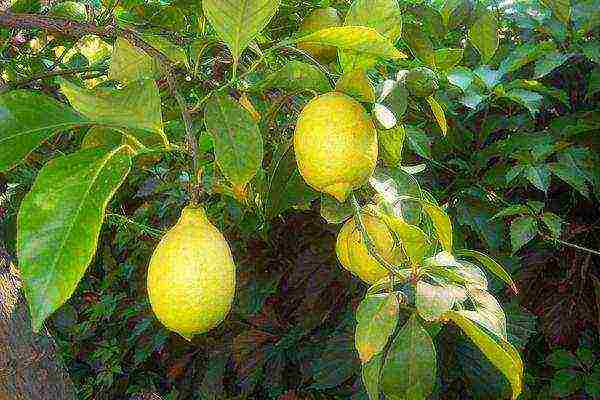
It blooms and bears fruit all year round, one of the most unpretentious varieties to care for. Even western and north-western windows are suitable for such a room lemon. It produces from 20 to 40 tasty fruits per year (many argue that they are even tastier than usual) weighing 120–150 g. Sometimes there are specimens up to 500 g. The peel can be eaten together with the pulp, usually 5–10 seeds, occasionally 20. Often found fruits without seeds. This lemon variety begins to bear fruit at 3-4 years of age.
It is relatively resistant to dry air, but reacts very well to crown spraying. The ideal humidity for him is 60–80%. In the house, it is usually grown near the eastern windows, although it can tolerate partial shade. But on the south window, burns are possible.
Meyer
Widespread for outdoor cultivation, where it is often grafted. In the apartment it is grown on its own roots. The height of the tree is from 1 to 1.5 m. The crown is well leafy and easy to form. There are few thorns. Leaves are glossy, dense and dark, serrated.
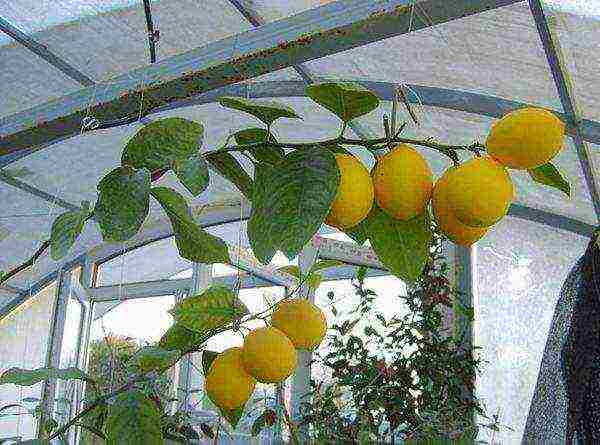
Refers to remontant and early ripening varieties, bears fruit abundantly, sometimes up to 4 times a year. Fruits are not very sour, up to 150 g. Buds appear only on young shoots released this year. It blooms earlier than other species, most often already in March or April. The flowers are small (3-4 cm), but very fragrant. They can be located singly or in inflorescences of 2-6 pcs. Ripening lasts 8-9 months, the fruits are removed slightly unripe.
These homemade lemons need to be carefully cared for: in winter they must be kept in a room where the temperature is no more than 12 ° C, otherwise the fruit may not set. They need regular watering and spraying of the crown. It is better to grow such a lemon near the east or west windows: the abundance of light will make the tree grow quickly, but will slow down the setting of flowers. Blackout is also harmful - leaves may begin to fall from it. It must be protected from drafts. Meyer can be grown from both cuttings and seeds.
Chinese
In fact, this is the second name of Meyer's lemon: this variety was brought from Beijing (for which it received the name "Chinese") by the researcher Franz Meyer (in whose honor the variety received the first name).
Anniversary
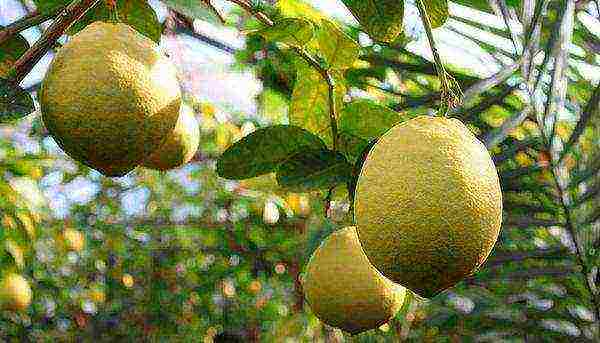
A hybrid bred in Uzbekistan, the "ancestors" of which were such lemon varieties as Tashkent and Novogruzinsky lemon. One of the most undemanding varieties to care for. Lemon Jubilee usually grows up to 1.5 m. It is a large-fruited variety (fruits up to 600 g). The skin is thick. This homemade lemon attracts many with its abundant flowering, during which the tree is almost entirely covered with white flowers with a slightly purple tint (also a "hereditary" feature of the variety from Tashkent).Usually they are collected in inflorescences of 14-16 pcs.
Like the variety bred in Tashkent, it begins to bear fruit for 3-4 years. It adapts quickly and easily tolerates room conditions: even in dry air and with low watering, fruits are set. True, it is difficult to obtain cuttings for propagation from this variety of indoor lemons: branches with buds are formed from almost every bud and leaf sinus.
Genoa
One of the rare species. Trees about a meter with a dense crown. There are almost no thorns. These lemons are distinguished by their particularly tasty fruits with delicate pulp. Their peel is edible, without bitterness.

Rather dense films inside are characteristic. Weight reaches an average of 110 g. The lemon grown from the cuttings begins to bloom in the 4th year. One of the important conditions for care is an abundance of light, without which the tree does not develop well. With good home care, it gives a huge harvest: in the first years of fruiting, it bears up to 50 fruits, and from an adult tree they can be harvested in about 120-180 a year.
Lisbon
Tall trees with large, dense and wide leaves. There are many thorns. The fruit is very tasty, seedless, with a thin edible skin, weighing 120–150 g. Very hardy variety. It develops well at almost any room temperature, it is resistant to heat and cool, as well as drought. Lighting loves bright, but diffused - direct rays of the sun should not fall. As a rule, it begins to bear fruit as early as 2-3 years. From this lemon tree, you can harvest up to 60 pieces in a season.
Maikop
The best varieties have been used for breeding this lemon. The result is an extremely productive crop: mature trees produce 100-300 fruits per year, and sometimes up to 700 are removed from old lemon trees of this variety! The fruits weigh about 140-160 g.

Trees rarely grow taller than 2 meters. They are hardy and unpretentious, home conditions are well suited for them. There are two subspecies. The first type is formed almost without stamping. The crown is dense, branched, with many branches without thorns, which are located horizontally or hang down slightly. Leaves with a waxy bloom, dark. Small flowers are collected in inflorescences of 3-5 pcs. It normally tolerates wintering in houses and ordinary indoor conditions.
The second variety is distinguished by strong, semi-vertical branches directed upwards. The crown is symmetrical. This type easily adapts to home conditions, but prefers wintering in a cool room.
Buddha's hand
If you wanted to know which lemon is the most original, then this is without a doubt the Hand of Buddha. Such indoor lemon is usually obtained for its decorative qualities. Most of all attention is attracted by its fruits: long, up to 40 cm, in the form of a bunch of bananas or a hand (for which the variety got its name). They consist mainly of a thick peel up to 5 cm, the pulp is very little, it is not juicy, has a bitter or very sour taste and is not suitable for human consumption, however, the zest is sometimes used for baking.
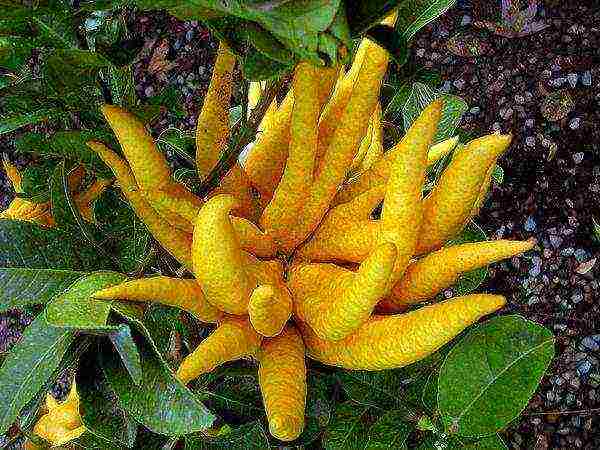
The leaves are oval and rather large. Home care requires plenty of light and warmth. Begins to bear fruit in the 3rd year. The fruits have a slight scent of violets. Sometimes this tree is used in perfumery.
Ponderosa
A hybrid that came naturally from crossing between species such as citrons and lemons (according to some versions, like the New Zealand variety). It has similarities with the Kiev large-fruited. It normally tolerates heat and drought, but before starting such a plant, you need to carefully read the care rules: the plant is sensitive to soil, reacts poorly to its excessive acidity, needs additional fertilizing. These lemon trees love diffused glare.
The trunk is up to 1.8 m. Strong branches, a spreading and wide crown, tough and dense leaves are inherent in this lemon. Flowers resemble jasmine - large, like the Kiev lemon, white-cream. Peak flowering in spring, from March to May.Just like the Kiev large-fruited lemon, it bears very large fruits - on average 300-500 g, but there are often cases when they reach 1 kg.
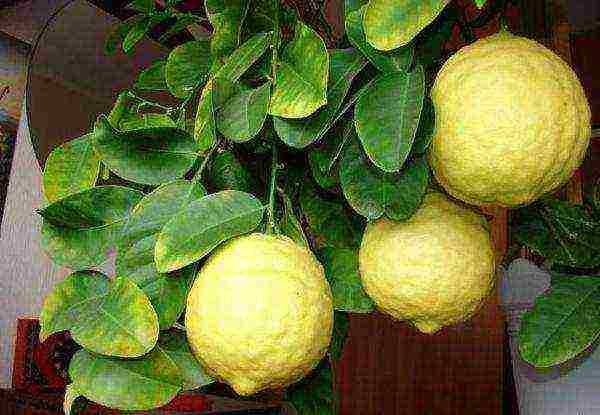
The peel is rough, rather thick. The pulp is juicy, pleasant to the taste, almost without the characteristic aftertaste of citric acid. There are many seeds. Fruiting begins in the 2nd year.
Volcano
Dwarf tree up to 1.2 m. Fruits are miniature (up to 4 cm), tasty, with a gentle sourness. You can decorate your home with these lemon trees, since they bloom all year round, and you can often see flowers and ripe fruits on the branches.
When watering, very soft settled water is important.
Lunario
One of the most successful varieties for an apartment. A tree of 1–1.5 m blooms almost continuously, and ripe fruits ripen on it at any time of the year. Flowers are solitary or in small clusters. The first flowers on these lemons can be found 2-3 years old. There are many thorns.
Fruits with a thin, smooth skin. The pulp is aromatic, not very juicy, slightly acidic. There are almost no seeds.
Novogruzinsky
Novogruzinsky is a vigorous variety, the height can reach 2-3 m. The crown is regular, dense and spreading. Fruiting 2-3 times a year, starting from the 4th (sometimes 5th) year of life.
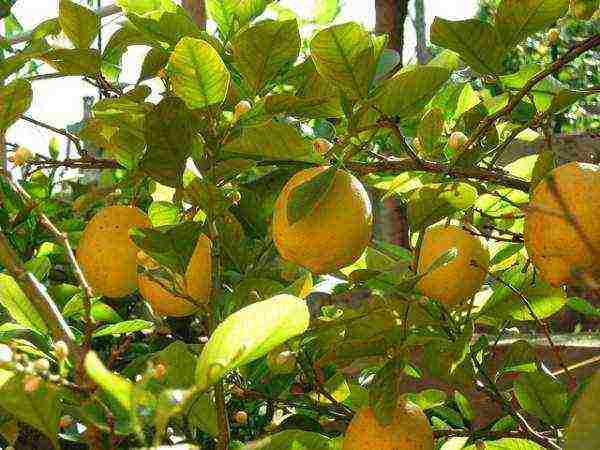
If the Novogruzinsky lemon is well cared for, it can produce up to 200 fruits per year. Their average weight is 130 g. Fragrant, juicy, sour. Large flowers have a light purple hue, single or in clusters.
Lemon Care Video
In this video, you will hear helpful tips for caring for your lemon.
Among exotic indoor plants, the lemon is perhaps firmly held by the palm. Already two millennia have passed since people learned to grow these citrus trees at home.
The fashion for homemade lemons came to Russia in the era of Peter I. Since then, this fragrant tree serves us not only as a decoration for our homes, but also is an excellent air purifier. Lemon foliage, fruits and flowers are capable of releasing in large quantities phytoncides, which, as you know, are natural antibiotics that rid the atmosphere of the premises where lemons grow from pathogens.
But not every kind of lemon is suitable for growing in an apartment... Indeed, in nature, this warm and light-loving inhabitant of the subtropics and tropics grows up to 5-8 meters. And by simply shoving a lemon seed into a pot of soil, you will most likely fail. It takes knowledge and a little effort to grow this gorgeous tree at home.
Lemon varieties for growing at home
First things first, you need to figure it out what kind of lemon suits your apartment or insulated loggia... Breeders have long bred decorative dwarf lemons capable of producing generous fruit yields. The most common among them are:
- "Novogruzinsky lemon" bears fruit all year round, has a delicate, delicate aroma, the fruits contain almost no seeds, and a large number of thorns grow on the trunk,
- Mayer, a dwarf lemon, which is famous for its especially sour lemons, which are eaten in an unripe state;
- Genoa also good for its fertility, fruit juiciness and decorativeness;
- Lunario gives a good harvest of oblong lemons;
- "Maykop lemon" is distinguished by fertility, fast growth rates and excellent decorative properties;
- "Pavlovsky lemon" - a time-tested, reliable variety, long mastered by lovers of home floriculture, grows up to 2 meters in height, it has thin-skinned, fragrant, large fruits.
In this article we want to describe all the subtleties and nuances of growing Pavlovsky lemon as the most common and highly productive.
By the way, about the yield
With proper care and normal keeping conditions, one six-year-old lemon tree in mid-latitudes can bear 20 to 50 fruits per year. In southern latitudes, the yield of ornamental lemon is twice as large - up to 100 fruits per year.Is this not an additional reason to try to grow a lemon tree in your apartment?
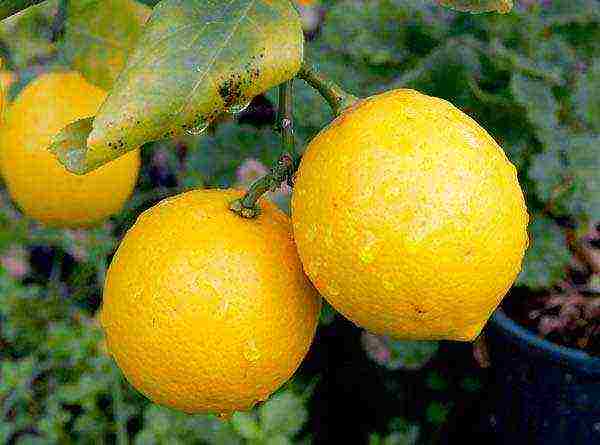
History of the Pavlovsky Lemon variety
For the first time in Pavlov-on-Oka, about 150 years ago, lemon came in the form of cuttings brought from Turkey by the merchant I.S. Karachistov. The merchant brought the cuttings as a gift to his relative E.D. Elagin. He then laid the foundation for this wonderful variety of lemons, having received exotic trees from cuttings. Growing lemons in homemade lemonaries has become fashionable throughout Pavlov. After the revolution, in the 30s of the 20th century, a special enterprise was even created in this city, engaged in the study and cultivation of Pavlovsky lemon.
Since then, this lemon variety has not only not lost its popularity, but has become widespread throughout Russia.
Description of Pavlovsky lemon
Pavlovsky lemon is a bush-shaped tree that can divide into 3-4 branches-trunk, grows up to 2 meters in height, but on average up to a meter and a half. A rounded crown up to a meter wide is formed by branches hanging down. Lemon branches, as a rule, grow quite impressive thorns of one and a half centimeters.
This plant has large foliage - up to 15 cm in length and up to 8 cm in width. The leaves are glossy, green and dark green in color. On their surface and along the edges there are special glands that produce essential oils. It is they who give us the opportunity to appreciate the citrus scent and antibacterial properties of this exotic tree. Lemon is an evergreen perennial plant. In nature, there are centenarians who live up to 45 years. Therefore, the leaves on Pavlovsky lemon rarely change, on average once every 2-3 years.
It's important to know
For one lemon, there should be at least 10 leaves on the tree. Therefore, the more healthy foliage your lemon has, the better the plant is and the more fruit it will bear.
Pavlovsky lemon is a self-pollinating plant. Its flowers are bisexual, five-membered, up to 3 cm in size. Lemon blooms, subject to normal maintenance, throughout the year. Therefore, on the same tree, you can often see both new flowers and ripening fruits at the same time. Lemon has two periods of abundant flowering - the beginning of spring and the first half of autumn.
The first fruits appear when the lemon reaches 2 or 3 years of age. But fruiting greatly depletes the young tree. Therefore, in order to grow a strong, beautiful plant, experienced plant breeders recommend picking off all flowers in the first two years of the life of this citrus, preventing it from setting fruits. In the third year, it is recommended to leave 3-4 flowers. In the fourth year - leave only well-developed flowers, removing nearby growing weak flowers.
Do the same with the fruit. Leave only the amount of lemons that can ripen. Lemons that are tied a short distance from the base and on short branches are more likely to survive. Therefore, give them preference when choosing fruits for ripening.
Lemons ripen within a month, but the fruits can continue to grow for up to a year. You should not leave ripe fruits on the tree, because over time they lose their external and taste qualities. Pluck the lemon fruit when it has its characteristic bright yellow color.
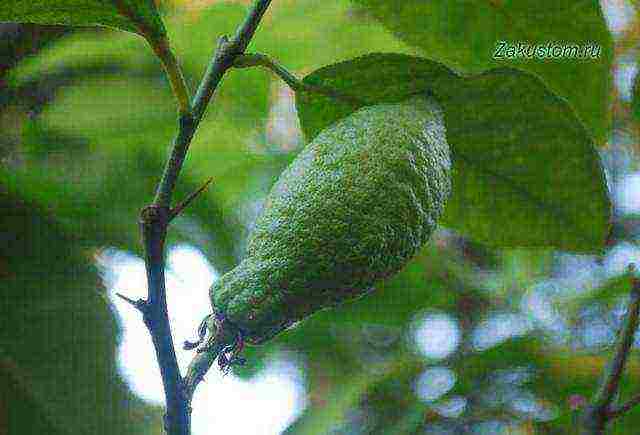
Habitat requirements
Lighting requirements
As with any tropical plant, the lemon needs to be provided with good lighting. But it should be borne in mind that the tree must be protected from direct sunlight. In the summer, you need to take care of the darkening with paper or rare fabric (gauze, tulle), and in the winter, arrange an artificial sun for the lemon with the help of backlighting lamps. The most favorable option would be to place the lemon on the west, south-east or east side of the house.
Given that the lemon does not tolerate a sharp change in habitat, in order to avoid the tree shedding leaves, refrain from taking the pot with the plant out into the open air.
Temperature requirements
A flower native to the tropics must ensure the temperature in the room where it is kept is not lower than +18 degrees. In winter, the optimal temperature will be in the range of + 14- + 15 degrees. Therefore, if you have an insulated loggia, you can send a tree there for the winter. But at the same time, take into account one feature: if the constant temperature in the room is above +18 degrees, water your lemon with water warmed up to +30 degrees. For the root system of a plant, the same temperature regime is required as for its aboveground part. Otherwise, your tree may simply go bald.
Moisture and watering requirements
The lemon tree does not like drought or waterlogging. Therefore, observe the measure when watering. Water your tree with warm water a couple of times a week. Spray the plant with a spray bottle in order to provide it with an air humidity of 60-70%. In winter, when the heating system dries up the air in the room, place containers with water next to the lemon or use an electric humidifier.
To prevent the lemon from dropping the fruits, it is useful to periodically moisten them with water at the place where the lemon joins the branch.
Reproduction of homemade lemon
Indoor lemon propagation can be done in three ways:
- air layering,
- seeds,
- grafting.
Seeds
The disadvantage of such planting is that in this case you will have to wait for the fruit for a long time - from 10 to 15 years. However, this period can be significantly reduced if you inoculate your tree with a bud with part of the wood and bark of an adult lemon tree, which has already borne fruit more than once. In this case, you will have to reap five times less. Your lemon will bear fruit in its 3rd year.
Cuttings
The most reliable method to get indoor lemon is by cuttings.... To do this, it is best to take a stalk in the first half of spring from the autumn growth of a healthy, well-bearing tree. With a sharp knife, cut a stalk half a centimeter wide and 10-13 cm long from a young, at least 25 cm long, not stiff branch. There should be 4-5 leaves on the handle. You cut off the two lower ones of them, and leave the upper ones or cut them in half. Please note that you should make the lower cut a quarter of an inch from the kidney, and the upper one at least 2 cm higher. Cut the stalk at a sharp angle.
Before planting, we recommend placing the cuttings in the growth solution. For it, you will need a mixture of the following drugs:
- 25-50 mg of indolylbutyric acid per liter of water,
- 0.1 g of heteroauxin per liter of water.
Even if you did not find the components for the growth solution, immediately before planting, you need to cover the lower cut of the cutting with a layer of crushed charcoal. After that, the cutting can be planted at right angles in a prepared pot filled with sand.
Some growers recommend planting cuttings in a special soil mixture, which you can buy in the store, or prepare yourself. To do this, in equal proportions, the sand is mixed either with sphagnum moss or high-moor peat. But this is only the layer that fixes the cuttings and supplies them with moisture. At the bottom of the container where you will place the seedlings, you need to lay out a layer of drainage (expanded clay, small pebbles, broken brick, etc.). Then we put a layer of 5 cm of a mixture of turf and forest land on it, after which we pour out the sand mixture. Now, our lemon cuttings can be placed in a container for planting in moistened soil. It is recommended to spray the cuttings from a spray bottle and then carry out the spraying procedure regularly.
Provide the plant with a planting area of 25 cm. Sq. You should arrange a greenhouse for your lemon with a film or can. If the temperature in the room is above +20 degrees, the greenhouse must be periodically ventilated.
After two weeks, the cuttings should begin to take root, and after a month and a half, your young lemon should be gradually accustomed to the atmospheric conditions of the room. To this end, ventilate the greenhouse daily and increase the ventilation time for two to three weeks.
You will be interested in:
We grow rootstocks at home for grafting.
How to plant lemon at home.
How to make money on growing citrus fruits
The first transplant of a seedling
When the plant takes root and takes root, it should transplant a lemon tree in a half-liter flowerpot. For him, it is necessary to prepare an earth mixture, consisting in equal shares of rotted maple or linden foliage, sod land and manure humus.
Lemon needs a nutritious soil, so take care of this beforehand. At the bottom of the pot we equip drainage, check that there are holes in it for the drainage of excess liquid, we pour a layer of river sand onto the drainage layer, then we put a nutritious soil mixture on it.
Transplant seedlings using the partial transshipment method, i.e. a little old soil should be left on the roots. If the roots of the plant are longer than the planting container, carefully lay them in rings, gradually sprinkling them with soil. After planting, the lemon must be watered with settled warm water.
Note!
When transplanting, never cover the neck of the plant with earth! If the neck is covered with soil, then over time it will begin to rot and your lemon will die.
Forming the crown of a tree
When you put the lemon pot in its place, refrain from moving or turning it frequently. The tree will slowly adapt to its new habitat, forming shady and illuminated foliage, getting used to the dose of light they receive. Therefore, in order to achieve a symmetrically developed tree, turn it no more than 2 times a month clockwise by no more than 30 degrees. If you turn the plant frequently and sharply, the leaves will dry out and fly around.
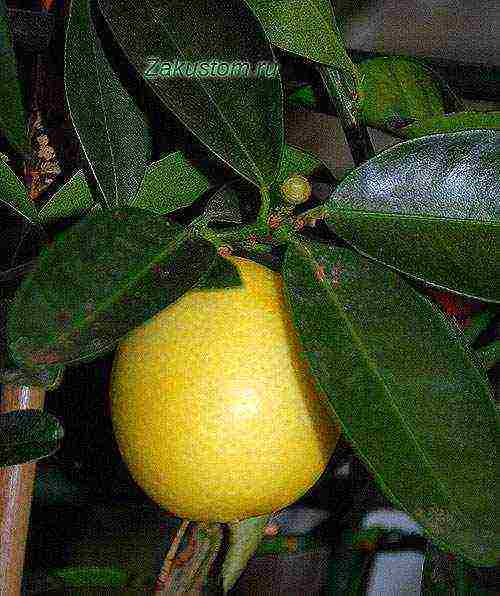
To form a crown exotic tree, you need to periodically pinch the shoots, stimulating the growth of new branches in the right direction. You will have to deal with the crown for two to three years. A young, only planted plant gives one upright vertical shoot, it is called zero. In the second year of growth, twigs of the first level appear. We need to get level 2-5 shoots. The branches we need may appear only after a few years.
How to do it?
- Pinch the zero twig when its height exceeds 20 cm.On the tree trunk, leave only healthy, developed buds that are directed in different directions.
- On the branches that have grown from these buds, you need to leave 4 buds each, they will then form the skeleton of our lemon. Skeletal branches should not exceed 25 cm.
- The branches of the second level should not exceed 10 cm.
- Shoots of the third level are half the length of shoots of the second level.
If you got a lemon tree by grafting, then it is best for you to form it in the form of a bush, if you have grown a grafted lemon, form a tree. In this case, fix the stem of the lemon with a peg, then it will grow vertically.
Features of care for seedlings
Watering seedlings
In the summer try to water the plant daily in the morning, make sure that the soil in the flowerpot does not dry out, is slightly moistened, but does not turn into a liquid porridge. Water the soil evenly over the entire surface of the flowerpot with the plant. If necessary, in summer, homemade lemons can be watered not only in the morning, but also in the evenings.
In winter the number of waterings should be reduced to 2 times a week in the morning.
Pay special attention to the water with which you water the lemon seedlings. Recommended water temperature - two to three degrees higher than the ambient temperature in the room where the flowerpot is.Cold water will acidify the soil and rot the root system of the lemon tree. Tap water is undesirable, but it is possible in a form that has been settled for a day. The best option would be rain, melt, river water.
Do not forget spray a plantthis will prevent drying out and loss of foliage.
Top dressing of seedlings
In order that after 3-4 months the nutrients in the soil of the pot with indoor lemon are not depleted, and the leaves do not lighten, the plant must be fertilized.
- To do this, in the spring, summer and autumn, use a liquid top dressing in the form of a solution of mineral fertilizers (2 g per liter of water).
- If you want to speed up the growth of the plant, use an ammonium nitrate solution.
- If at the top of a homemade lemon, the foliage begins to turn yellow at the edges, use sulfate or potassium, chlorine-free fertilizers.
- When the lemon tree is two years old, fertilize it with phosphate-potassium mixtures twice a month. To prepare such a mixture, you will need 5 g of potassium salt and superphosphate per liter of water at the rate of 300 g of the mixture per tree. But, in order not to burn the root system of the plant, it must first be watered.
- Throughout the year, lemon should be fed once every two weeks, with the exception of winter - once a month.
Used to feed indoor lemons and organic fertilizers such as bird droppings or slurry. Litter is diluted with water in a ratio of 1 to 20, slurry 1 to 15.
It is useful to fertilize foliage by spraying or brushing with a brush with a solution of boric acid (half a gram per liter of water), or wood ash (1 tsp per liter of water).
If you use mineral and organic fertilizing in combination, take care to halve the dose of fertilizing.
With a lack of microelements in the lemon nutrient medium, you can stimulate the growth of foliage with a weak solution of potassium permanganate, if the foliage turns yellow, feed the lemon with a solution of copper sulfate (2 grams per 1 liter. Inputs) every 5-6 days.
In stores, you can find complex fertilizers for lemons, use them as indicated in the instructions on the package.
It's important to know!
Until your cuttings have taken root, refrain from feeding them.
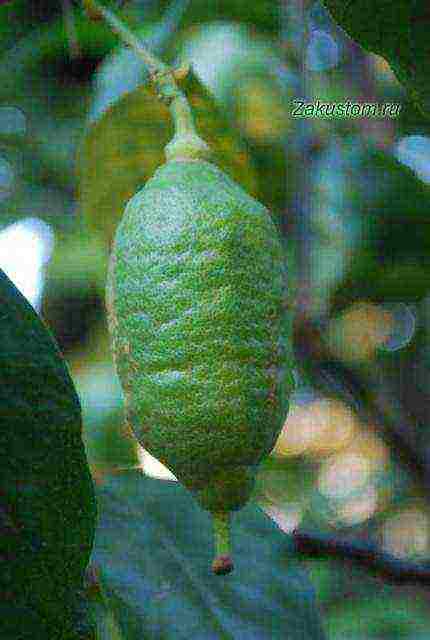
How to transplant homemade lemon
You need to replant the lemon tree once a year in any of the spring months. But, only when the root system has occupied all the space in the flowerpot. You can check this by looking at the holes on the bottom of the pot, if you see the roots sticking out from there, the lemon needs to be replaced.
If the soil in which the tree grows is normal, the transshipment method is used, if the substrate is acidic, it must be changed, then the transplant method is used.
When transplanting get rid of the old substrate as carefully as possible, revise the root system by cutting off the rotten roots. It is advisable to use an old pot at the same time, since you have removed diseased roots and the volume of the root system has decreased. Only care should be taken to increase the drainage layer and fresh nutrient substrate.
When transshipment the lemon tree is transferred along with a lump of soil into a new, preferably clay pot. You should not choose a flowerpot much larger in size, take a container 2-3 cm larger in diameter.
The fact is that the roots of the lemon should occupy the entire space of the pot, then it will have time to absorb all the moisture from the soil, while the latter will not sour. On the other hand, this situation can lead to intensive growth of shoots, which will weaken the tree and prevent it from blooming. In this case, refrain from transplanting the lemon until the flowering period begins and the roots take up all the space in the flowerpot.
In order to transplant the lemon by the transshipment method, water the tree abundantly, so that the soil in which it grows is completely saturated.Prepare a new pot by placing a layer of drainage and a layer of fresh substrate on the bottom. Then, grasping the trunk of the tree near the neck with your index and middle fingers, holding the top layer of earth with your palm, gently turn the pot upside down. You can hit the pot on a hard object if necessary.
Carefully separate the clod of earth with the root system from the pot, inspect the roots for decay. If there are any, cut them off. Remove the topsoil, discard old drainage, and move the lemon to a new home. At the same time, try not to damage the root processes of the plant.
Fill the free space in the flowerpot with new soil, tamp the earth in such a way that there are no empty spaces in the pot. In this case, the soil level by one and a half centimeters will still be below the upper edge of the flowerpot. Do not forget that the neck of the lemon must remain on the surface, otherwise it will quickly rot and your lemon will die.
After transplanting, pour plenty of lukewarm water over the lemon. Refrain from feeding the plant until it completely takes root in a new place.
Homemade lemon pests
If you grow a lemon tree in an apartment, be sure to make sure that unwanted guests such as aphids, scale insects, or spider mites do not settle on it. All of them invariably lead to the weakening of the plant and, as a result, its baldness.
Aphid, a yellow-green insect that can settle in the tops of twigs, feeds on the sap of the foliage. In order to get rid of this pest, place a flowerpot with fragrant geraniums next to the lemon tree. The smell of geranium will keep aphids away. Or rinse the ground part of the lemon with one of the following preparations with improvised means (knitted fabric, toothbrush, gauze):
- dissolve chlorophos or karbofos (30g) in 10 liters of water;
- dissolve anabazine sulfate (30g), laundry soap (40g) in 10 liters of water;
- stir well 5 g of laundry soap and 10 g of kerosene in a liter of water;
- chop the onion on a fine grater;
- make a tincture of garlic (for a day, 3 crushed cloves per 1 tbsp. water);
- make a tincture of red bitter pepper;
- dissolve washing powder in water;
- steam the infusion for a day in a sealed container (in a ratio of 1 part of tobacco dust to 10 parts of boiling water), then add soap and denatured alcohol to it.
In the same way, you can fight against scabbard, a fleecy, dark brown pest that lives on the veins of lemon leaves. In case of severe damage, the scabbard can also cover the stems of the plant.
It's important to know!
Use pest control with great care. Process the plant only in a non-residential area.
To get rid of the scabbard, process the plant once per decade, you will need 3 or 4 such procedures. Before processing, try to remove all pests from the leaves, then thoroughly rinse the affected areas. All this time, foliage needs to be examined daily and newly appeared pests must be removed. Rinse the place where the scabbard was sitting with one of the proposed solutions.
During processing, try to do so that the preparations do not get into the ground, burn used rags and toothbrushes. During the entire treatment period, do not let the sun's rays fall on the foliage of the tree. Otherwise, burns are possible.
Spider mite can start in a hot dry room. It feeds on the sap of the foliage, braiding it with a cobweb from the underside. In this case, the foliage loses its color and falls off. Methods for dealing with mites are similar to those for aphids and scale insects. But there are other means: foliage, especially its underside, can be sprayed from a spray bottle with tinctures and decoctions of horse sorrel, onion or garlic husks, tobacco, dandelion, potato tops, yarrow.
With excessive watering in lemon, whitish small fleas - podura... You will get rid of them if you water your tree less often, but more abundantly, and do not forget to loosen the soil well. You can sprinkle dry soil in a flowerpot with dust or wood ash.
Earthworms by themselves, they cannot bring any harm to the plant, but in the case of abundant reproduction, they can block the drainage holes in the pot, which will inevitably lead to rotting of the root system and acidification of the soil. Therefore, it is better to get rid of them in one of the following ways:
- Drizzle the lemon with a weak pink solution of potassium permanganate or mustard (1 tsp mustard powder per liter of water);
- Fill a basin with water heated to 50 degrees, gently and slowly lower a pot with lemon there. From the hot "bath" the worms will climb out. Collect all the worms from the soil surface.
Diseases of indoor lemon
When a lemon is weakened by insect pests, diseases such as gommosis or sooty fungus can appear.
Sooty fungus, which feeds on the waste products of scale insects, leads to disruption of photosynthesis, it becomes difficult for the plant to "breathe". You can get rid of the fungus as follows:
- get rid of the scabbard,
- make sure that the room where the lemon grows is regularly and thoroughly ventilated,
- Spray or treat the lemon tree at least 2 times with a 1% solution of Bordeaux mixture.
Gommoz - a disease in which a brownish glue-like substance - gum is released on the ground part of the lemon. Most often, the disease occurs due to mechanical damage, improper use of fertilizers or damage by harmful insects. This disease leads to the death of the bark, the formation of wounds on the trunk and foliage falling off. To fix this problem, you must:
- correctly use top dressing, get rid of pests,
- clean the affected area to healthy layers, treat it with a three percent solution of Bordeaux mixture, cover with garden varnish,
- disinfect the tree by sprinkling it with copper sulfate.
How to choose a lemon tree in a store
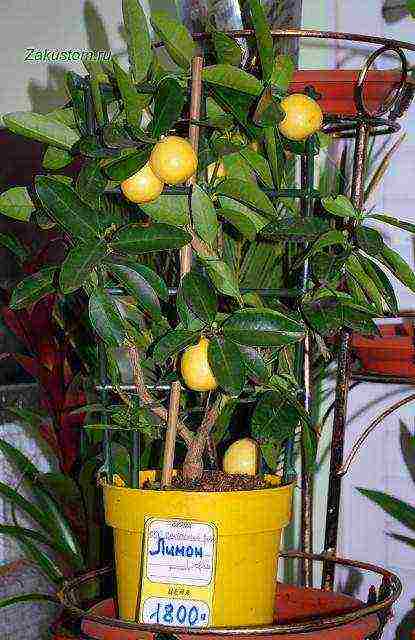
Room lemon in the store, February 2015
In conclusion, we want to give some advice to those who decided to take the simplest path - to buy a ready-made lemon in a specialized store.
1. Buy only varieties adapted for growing in apartments - "Mayer", "Genoa", "Lunario", "Maykop lemon", "Pavlovsky lemon", etc.
2. Given that the lemon is quite difficult to adapt to the new conditions of detention, try to choose trees, grown in local nurseries, not Holland or Greece. Such plants will not live long in our conditions.
3. Give away preference for lemon grown from cuttings, not seed-grown lemon. The fact is that the latter do not inherit the qualities of their "parent", and you run the risk of buying a "pig in a poke". Vegetative lemons, on the contrary, are indistinguishable from their ancestor. You can find a lemon grown from a cutting by the root system, its roots grow on the sides from the bark of the stem, a lemon from a seed has one well-developed root, and smaller roots grow from it.
4. Do not buy lemons in pots with a washcloth or sponge-like substrate... It is impregnated with preservatives, therefore, a lemon tree will live exactly as long as the preservative will act. Even transplanting into another pot with nutrient mixture will not help.
As you can see, it is not so easy to grow a lemon tree, but the lemon will surely reciprocate your love and care, pleasing your eyes, giving you health and an incredible aroma - the aroma of happiness and home comfort!
Read related articles
Many people cannot imagine tea without a slice of fragrant lemon, which also adds a special taste to the drink. Citrus fruits are useful, they are rich in vitamin C, help us in the treatment of colds, raise immunity.Lemons are most often imported to our country from Turkey and Egypt, they go a long way before getting to our table.
People who grow lemon at home will be able to say with confidence how much the aroma of these citrus fruits is stronger. The lemon in the room is grown not only for the purpose of obtaining fruit. It is also a beautiful indoor plant with glossy leaves, it brings positive energy to the room, exudes useful phytoncides. Lemons ripe at home will become a real joy for children and an amazing exotic for guests. Should you grow lemon at home, and which variety should you choose?
Pavlovsky lemon
This variety got its name due to the fact that it was bred about 100 years ago in the village of Pavlovo, Nizhny Novgorod region. It is considered one of the best and most suitable for indoor growing.
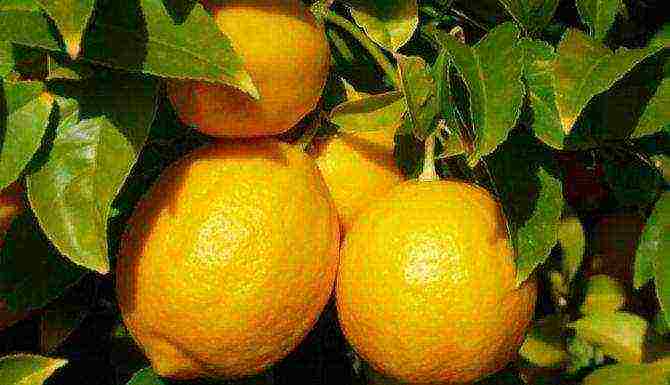
Pavlovsk lemon is the most popular home grown
The main advantages are self-pollination and resistance to lack of sunlight. Most lemons cannot stand direct sunlight, so the pot should be placed on the west or east side. However, diffused light is vital for the plant.
"Pavlovsky" can grow up to 2 meters, so you need to optimally select the space for it. It produces 20 to 80 fruits per year, depending on age. The plant bears fruit already in the first year, but it is better to remove the ovary before reaching the age of three, so as not to weaken it. The Pavlovsky lemon grows quickly - up to 50 centimeters per year.
The main conditions for this variety are high humidity, heat at least 20 degrees, watering and spraying. In the summer, you cannot take it outside, otherwise the plant may shed its leaves. Ripe lemons are recommended to be cut off immediately, otherwise they become unusable, although they can hang on the tree for up to a year. Fruits are fragrant, slightly sweet, some are seedless.
Lemon Meyer
Introduced back in 1929, it is considered a dwarf. It gives a good harvest even in the open field, therefore it is popular. The tree reaches a height of 1–1.5 meters. The flowers are fragrant and bloom all year round.

Meyer lemon variety
The main conditions are abundant diffused light, watering and spraying, drainage, top dressing. The plant does not tolerate cold, climatic changes and drafts; in winter it can shed its leaves. For the winter period, this kind of lemon is removed in a cool room.
Fruits with a thin skin, have a strong aroma, they are sour, there are seeds. The fruit can be removed from acid by intensive watering (2 times a week).
Genoa lemon
The main advantage of this lemon variety is that the fruits are of the highest quality, they have a pleasant, juicy pulp and an edible rind. The plant bears fruit well, at maturity it gives a large number of fruits. Lemon begins to bear fruit at 4 or 5 years.
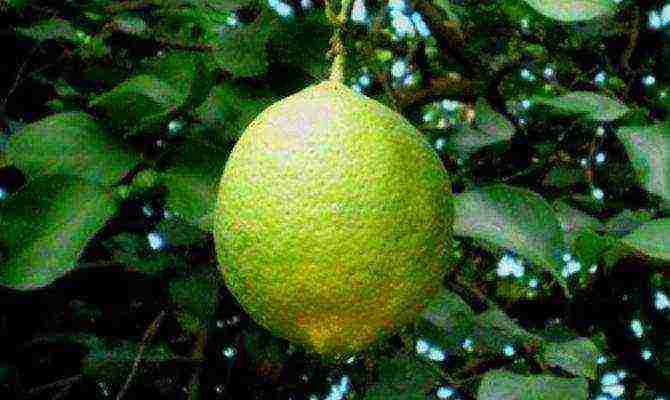
Lemon Genoa
The main conditions for keeping this plant are an abundance of diffused light, southeast windows.
The variety is considered rare, the tree reaches a height of 3 meters. There are no thorns on it, it blooms several times a year.
Lemon Eureka
Eureka lemon will become a real exotic at home. The fruits are striped, the buds are purple, the leaves are variegated. The flesh of the fruit is also unusual - it is pink. The main disadvantage is the low fruiting of the plant. The fruits are very sour, but juicy, with seeds.
Maykop lemon
The variety appeared thanks to improvement by folk breeders. The plant bears fruit very well, up to 300 lemons per year. Some breeders managed to get up to 700 fruits. (this is possible only in a greenhouse)
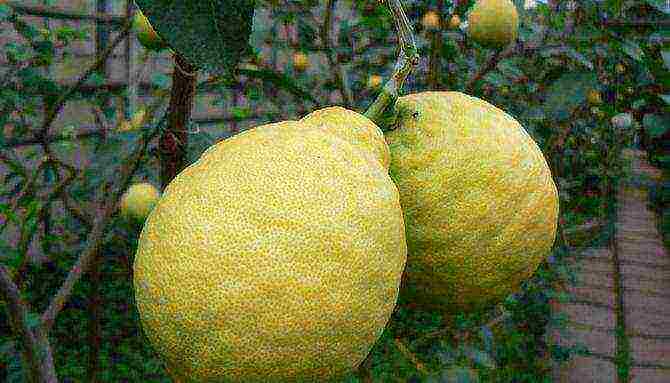
Maykop lemon
The advantage is that lemon is unpretentious, it tolerates winter normally in cool rooms. There are several varieties of this lemon. The fruits are fragrant and large, juicy, weighing up to 140 grams.
Lemon Grade Buddha Hand
Another unusual lemon is the Buddha's Hand. It will attract attention with its unusual shape of the fruit, which resembles a hand with long fingers. The main disadvantage is that the fruit is not edible, as it is bitter and dry.
This variety is used more in confectionery. It is rarely grown indoors because of the whimsical nature and height of the tree (1-3 meters).
Ponderosa lemon
The variety appeared due to the fact that a lemon and a pomelo were crossed. The taste turned out to be hybrid (there is no usual acid, the pulp is tender), but the fruits are large, they can weigh up to 1 kilogram. The lemon of this variety has a lot of seeds.
The plant is not very whimsical, it tolerates heat. It is important to monitor the soil, its acidity, and fertilize ponderose in time.
Lemon variety Lisbon
The plant reaches a height of 2 meters, it is considered a fast growing tree. The fruits have a high taste - they grow up to 200 grams in weight, the pulp is sour and juicy, pitted lemons.
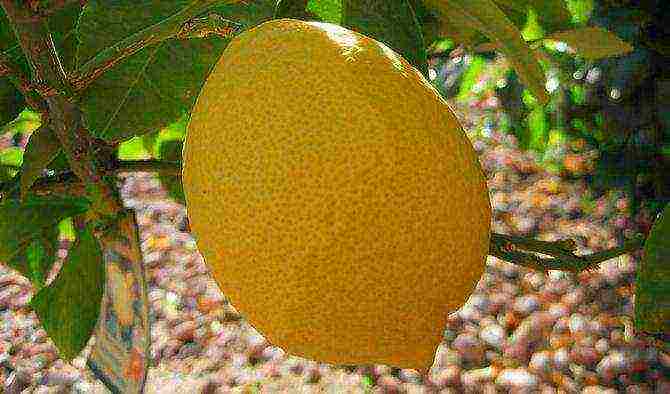
lemon grade Lisbon
The plant is considered to be fruitful, well tolerant of cold and heat, wind.
Villa Frank Lemon
A tree of medium height, without thorns, gives a small yield - no more than 5 flowers per plant, and accordingly fruits. The average fruit size is 100 grams, it is juicy and sweetish. The variety is demanding in care, needs the right light regime.
Irkutsk lemon
A kind of lemon with large fruits, they reach a weight of one and a half kilograms. The plant is not picky, it does not require frequent pruning, bears fruit 2 times a year. The flowers are large and beautiful, collected in inflorescences.
Slightly similar to this variety and "Kiev large-fruited", which is distinguished by the need to form a crown. Both types of lemon are often used in interior decoration, as they have beautiful large leaves and flowers. The flowers are also very fragrant.
When choosing a lemon variety, you should be guided by such basic criteria - what is more important, decorative qualities or yield, fruit taste. It is also important to navigate in conditions that can be optimally maintained for a particular variety.
Growing citrus plants at home has become very popular among florists. Especially for these purposes, breeders have bred mini-varieties of orange, tangerine, grapefruit and lemon, as well as other species. This article will focus on the latter of the plants listed above.
Lemon at home. Growing it can create a number of difficulties, since this small tree is very whimsical. In order for citrus to delight you not only with its evergreen, bright leaves, but also begin to bear fruit over time, you must adhere to some rules for caring for it.
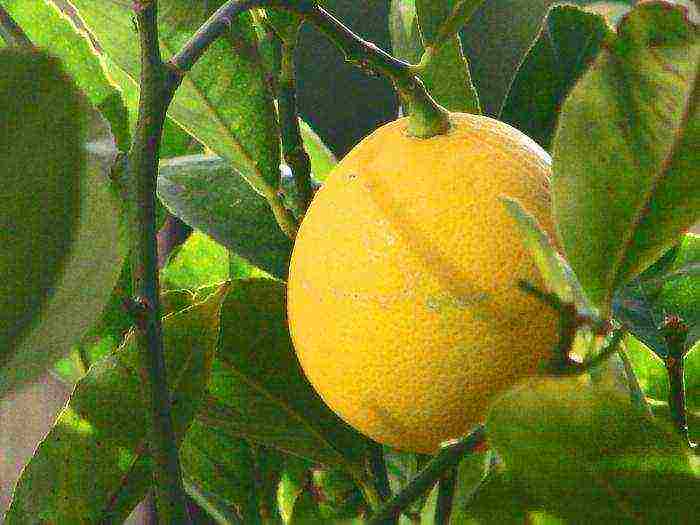
Lighting
The largest number of varieties of lemons are light-loving, with the exception of only a few of them (Pavlovsky, Yubileiny). The north and north-west windows of the apartment are well suited for them. The rest of the plant varieties can be placed near sunny southern and southeastern windows. However, in this case, it is worth shading the lemon: growing it can be complicated by direct sunlight, since the leaves can get sunburn. When winter comes, citrus must be placed in the brightest place in the apartment, but you must remember that this tree hibernates in the cool.
Pots. Substrate
It will be comfortable enough to grow lemon at home, the cultivation of which is best done in spacious wooden tubs, this improves air access to the root system. The soil for plants can be purchased at the store, it should be loose, but very nutritious. In order to make the soil at home, you will need to mix humus, turf soil and sand in proportions of 1: 3: 1.
Watering and humidity
Citrus fruits do not tolerate dry air well, so do not place them near batteries.If there is no other place suitable for plants, then cover the battery with a wet cloth. Like all citrus trees, in the summer, you must not only water abundantly, but also spray your lemon with water from a spray bottle. Growing such capricious plants at home always requires soft water: it must be boiled or defended for a day, even better - 2-3 days. Sometimes it is worth rinsing trees under a warm shower (small specimens) or washing the leaves with water and a cloth (adults and large plants). In the winter season, watering is reduced, as this can lead to stagnation of water and decay of the root system (an exception can be made if fruits appeared on your trees at this time of the year).
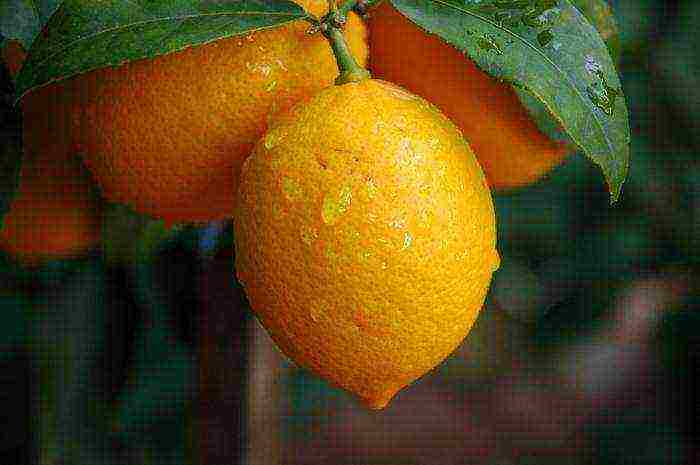
Top dressing
It will be good to make fertilizing with mineral fertilizers. This should be done during the period of active growth of the tree, that is, from spring to late autumn. Fertilizing citrus is necessary not only for its healthy growth, but also for the start of fruiting.
Ovary and fruiting
If during flowering it is not possible to take the plant outside, then pollination can be done on your own using an ordinary paintbrush. To do this, pollen is carefully taken on a brush from one flower and transferred to another. This should be done with all colors. How soon will lemon start bearing fruit at home? The cultivation took place according to all the rules, which means that you can wait for the harvest in the third - fourth year.
It is worth remembering that only grafted trees bear fruit, only in rare cases it happens that plants grown from a stone form ovaries. And even then, most likely, it will be barren flowers.
Temperature regime
The optimum temperature for this plant in winter is 12-15 gaduses. It is considered high already at 23 degrees, if the air is still dry and hot - the leaves begin to curl up and dry out.
Transfer. Pruning
A young citrus tree is transplanted two or three times a year, taking into account the growth rate, and older plants are transplanted every few years (usually 2-3). This should be done at the very beginning of spring, while making sure that new shoots and even more ovaries of flowers do not have time to form on the tree. When transplanting, you need to take into account the location of the plant's root system. The root collar of the citrus should be slightly below the level of the pot.
Like many other plants, lemon at home requires good drainage. It is grown, as already mentioned, in a spacious container, on the bottom of which you can pour coarse sand, put charcoal, and small river or sea pebbles are also suitable.

With proper and careful care, this citrus will delight you with its fruits every year, and with its bright green foliage - throughout the entire time in your apartment.


